Perhaps you said "no", or you don't know what Okinawa is, but after seeing that, I'm sure that you, like me, are now filled with an overpowering compulsion to go there as soon as possible.
Now that it's approaching summer time, and it's getting warm without being scorching, I want to get outside and go to the beach, and Okinawa is the best place to go. The breezes are cool, the sea is calm, and, well... did you SEE that commercial?!
Okinawa is to Japan like Hawaii is to the United States. Okinawa and Hawaii have a lot in common, culturally, but my meaning is that Okinawa has always had a very rich and unique culture all its own, and now that it is a part of Japan, it strives to continually be aware of the history and influence its people have always had, and classifies itself as an entirely different place from the mainland. Stepping onto Okinawan soil, everything just looks and feels different. Most people speak the Okinawan dialect, but still present is the Okinawan language itself, which is entirely different from Japanese. There are also distinctive religious differences, and they even have their own brand of yōkai, which I'll touch on later.
The birthplace of karate, most likely derived from Okinawan and Chinese martial arts, the Ryukyu islands themselves, as well as several other key phrases and words are derived from the Chinese language, since the two are considerably close to one another. Okinawa's climate is subtropical, filled with interesting fruits and plant life, as well as fish and reefs and some of the best scuba-diving, fishing and surfing that you can ever experience. But I'm not going to sit here and give you a history lesson. Much information can be found via a quick google or wikipedia search. But I would like to share some key cultural factors that I find interesting.
Okinawan food is delicious. Pork is a common meat used in dishes (and my favorite besides seafood), and they are famous for a wide variety of very distinctive types of ramen. Also known for their brand of soba soups (though the noodles are udon-style with a different broth) many ingredients are imported into the cuisine and make for interesting and unique flavour. At times even overpowering, being a fan of spicy food, Okinawan cuisine introduced me to the Mexican and Thai brand of dishes. Another famous ingredient is called goya, or bitter melon, the most bizarre fruit I've ever tasted, and that's saying something. The name is accurate, to say the least. There's even bitter melon-flavoured drinks, noodles and candy. Along with that, a type of doughnut, called sata andagi, is another culturally significant dish. The sugary fried buns are often recommended as a sweet treat to those who are visiting or would like to try Okinawan cuisine.
But to really get a good idea on the history, culture and interesting places in Okinawa, you'll honestly just have to visit. I'll just take you through some notable places as if you were having a holiday there, but to do so, I'll need my assistants who help me explain all the most traditional and exciting aspects of Japan. I speak, of course, of Kagrra,.
Back in 2005, Kagrra, and their fanclub, Auga, took one of their random-ass get-togethers to Okinawa, and recorded much of it for an hour-long special in their now-defunct web program, Kagrra, no Su. They visit a few attractions, and take part in some famous cultural activities, so I figure if anyone would have a good idea on what I should talk about when it comes to all things Okinawa, it would be them.
They first visit the appropriately named "Okinawa World". Akiya has an up-close-and-personal experience with an albino python at the Snake Park.

Kagrra, also does a tour of the Gyokusendo Caves, the park's most popular attraction.

Besides Okinawa World, they also visit the Southeast Botanical Garden.
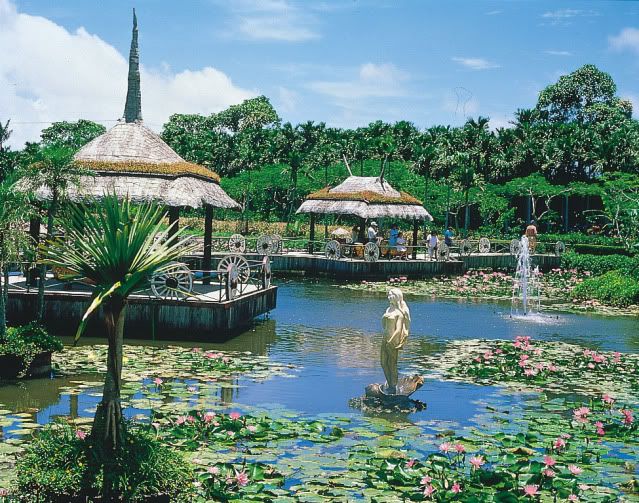
With all of the touristy stuff out of the way, Kagrra, returns to spend time with their fans, and has set up a staggering array of traditional Okinawan crafts and activities for them all to take part in.
First, they participate in tie-dying a handkerchief. Okinawa and the Ryukyu islands are very famous for their many methods of dye and patterns on woven fabric, but the most famous is the bingata style. Using cut-outs or stencils with interesting and distinctive patterns, the designs have since become very popular all over Japan, and bingata-style shirts, household goods and other types of clothing articles with the design on them are highly sought-after. Naturally, the most expensive and unobtainable article of bingata clothing is the kimono, which is most often seen worn by dancers performing the traditional Okinawan dance accompanied by yotsutake, an instrument made out of bamboo that has since become associated with Okinawan music and festivals.
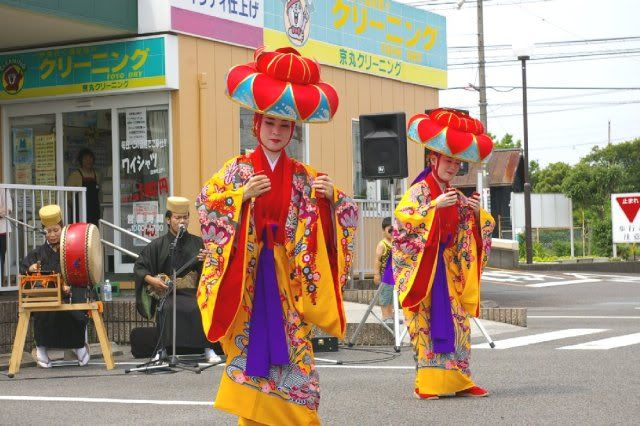
Speaking of Okinawan music, Isshi and Shin treat the fans to a performance of "Kaze ni Naritai" by The Boom.
The Boom, another band I really like, is the Okinawan version of Kagrra,. Their music blends rock with traditional Okinawan sound and sentiment, though they have released a few albums focusing solely on traditional Okinawan music in Uchinaaguchi, the Okinawan dialect. Here is The Boom's "Kaze ni Naritai".
If that song doesn't make you want to party, I don't know what will.
However, their most famous and popular song is called "Shima Uta", which is now synonymous with folk music (min'yo) from the Ryukyu islands. The song itself has been adopted as the anthem of Okinawa, written by The Boom's vocalist Miyazawa Kazufumi. Interestingly enough, all members of The Boom are from mainland Japan, and Miyazawa wrote the song from his impression of visiting Okinawa for the first time. Regardless, their music is heavily associated with Okinawan folk music, and no wonder, since the song and video itself, sung in the traditional min'yo style, glorify the sights, sounds and spirits of Okinawa.
It has sense been covered repeatedly by other artists, including, surprisingly enough, Gackt, who performed it on the TV show "Bokura no Ongaku".
So hopefully you will check out The Boom and become a fan of them, too.
So after all that, Kagrra, ends the experience by culminating all of this together with the dance most representative of the Ryukyu islands and Okinawan culture, eisaa.
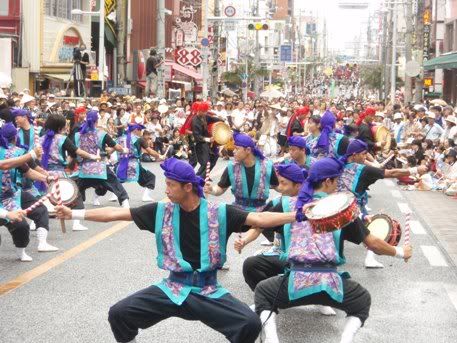
Though generally associated with the Bon festival, eisaa is strictly a Ryukyuan tradition. The history is standard, however; originally a religious practice of Buddhism, a song and dance would be performed in honour of the dead. Since this is a highly respected practice, as well as a common function of a monk's interaction with the people, the monks would come and sing songs praising Buddha and explaining teachings, so that the message could be spread. Eventually, local minstrels (ninbuchaa) would perform these well-known songs, but soon replaced the religious songs with Ryukyuan folk music, and the hired minstrels would perform their version of the dance. This is how eisaa became more widespread (though each local area has their own version of the singing and dancing because of it), and is now a popular tourist experience associated with traditional Ryukyuan culture and celebrations.
While it is up to the performer to decide to wear something traditional or not, or something unique to their local area only, the look of the traditional eisaa dancer's outfit does have some consistencies. A knotted scarf is worn on the head, though sometimes headbands are used instead. The dress of the performers are not inspired by Japanese clothes at all, but rather a Chinese garment style. Because of the Ryukyu islands' history and location in reference to China, the clothing is taken from an entirely different era and class of Chinese costume, instead of the kimono's precursor, the Hanfu-inspired dress worn in the Heian period.
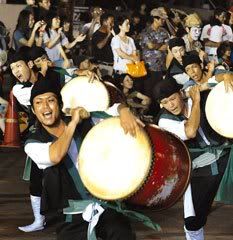
There are many traditional instruments associated with eisaa and Ryukyuan/Okinawan performances, and though some feature traditional Japanese instruments that include various types of taiko drums, wooden flutes, koto, or castanet-style percussion (like the hyoushigi), specific types of instruments from Okinawa are the obvious choice. Along with the aforementioned yotsutake, as well as it's cousin the sanba, whistles and the hand-held paaranku drum are very often seen, since these instruments are easily brought along to move through the streets like a parade, rather than a performance at a fixed location.
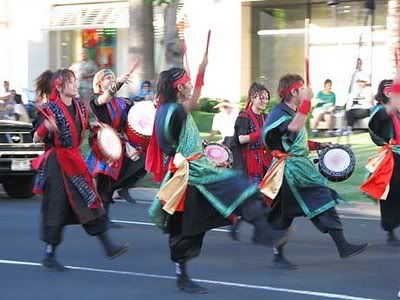
Perhaps the most famous of Ryukyuan instruments is the stringed banjo-like sanshin. Related to the shamisen, though more heavily if not exactly taken from the Chinese instrument sanxian, the sanshin is a favourite of Min'yo folk music in the Ryukyu islands.
After this performance, Kagrra, is put into eisaa costumes and taught some dance moves. They then get Auga together and have a brief performance, before teaching them some moves and drum accompaniment.
So that's Kagrra,'s trip through the traditional culture of Okinawa. But what about modern culture?
Like I was mentioning, with my PS3 I was also excited to get Yakuza 3. Though the fourth installment in the Ryu ga Gotoku series is already out in Japan, here in America, we're just now getting the third one, and it is the inspiration for today's entry, so I'll focus on it.
In gameplay, Yakuza 3 is similar to Grand Theft Auto. While not an open-world game, you do play as a badass character who lives in thinly-veiled versions of real cities, and have a multitude of weapons, personal interactions, and side-missions that you can choose whether or not to participate in while progressing the overall story. You also get to run through downtown Shinjuku and beat the crap out of people while taking photos with your cell phone to upload to your ameblo. I know you dream about it.
This installment, however, also takes place in Okinawa, where the main character, a former member of the yakuza, has settled to open his own orphanage.

Don't ask.
The settings have a really excellent way of capturing the look and feel of the places they represent, and the orphanage and downtown Okinawa are no different. As you make your rounds of plot-filler, fetching and solving missions in order to inspire and assist your young charges, you also get introduced to the people of Okinawa, who are alternately wary of mainlanders or extremely eager to share their culture with you, including the foods, music and activities I've mentioned. There is also an eisaa minstrel playing traditional folk music on his sanshin, and you have the choice of whether or not you want to save him from some punks who come to beat him up and try to destroy the sanshin he has been given by his grandfather. If you don't help him, may heaven have mercy on your soul, because I will personally hold it against you forever.
On every roof and street corner can be found a shisaa, an Okinawan yōkai closely related to the Chinese and subsequent Japanese shishi/koma-inu, a sort of lion-dog hybrid creature that is thought to ward off evil.
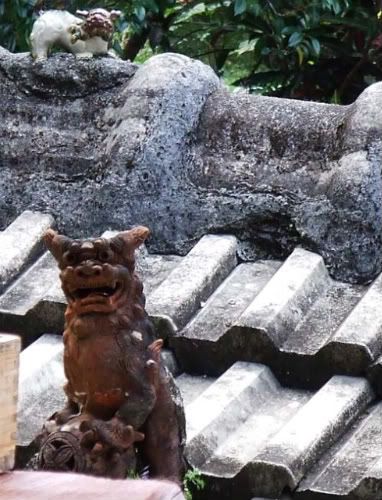
The shisaa is so prevalent in Okinawa that is has come to be known as the mascot of the islands, and along with them on every street corner can also be found a tourist loudly exclaiming how cute they are and how they'd like one of their own. It's so eerily like wandering around downtown Okinawa, it's frightening.
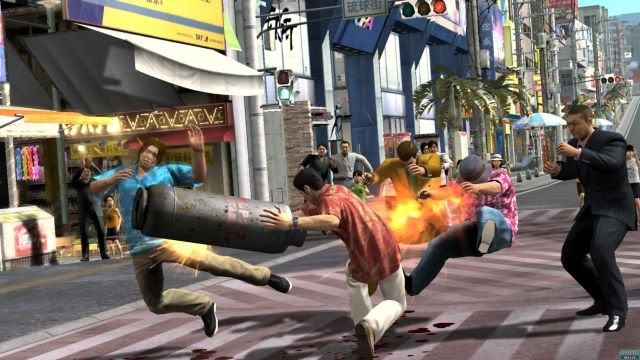
Such startling accuracy.
Gameplay elements aside, you really do feel like you're some amazingly awesome yakuza hero while you play it, it completely immerses you into that environment. For example, check out those cool Aloha shirts several of the men are wearing. As I mentioned, Okinawa is subtropical, and surfing and that sort of thing are extremely popular, so Aloha shirts are a popular thing to wear or for a tourist to buy. Beyond that, however, the shirts are extremely popular among yakuza or punks who want to feel like yakuza. Naturally, slick outfits are a staple of yakuza style, be it suits of questionable fashion in big cities, or the like of trends in whatever location you're in. Having oneself a good Aloha shirt is a must for any yakuza hanging out in a place like Okinawa.
I also have an Aloha shirt of my own, passed down through a relative. From the mid-50's, this Aloha shirt came from Okinawa. The design, however, is more traditionally Japanese than touristy Hawaiian-inspired.
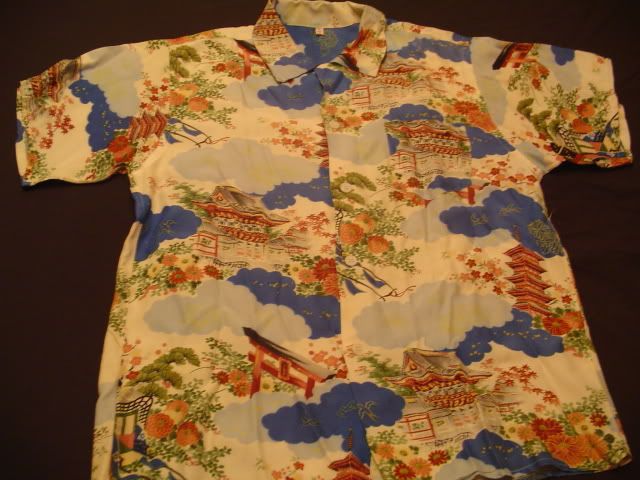
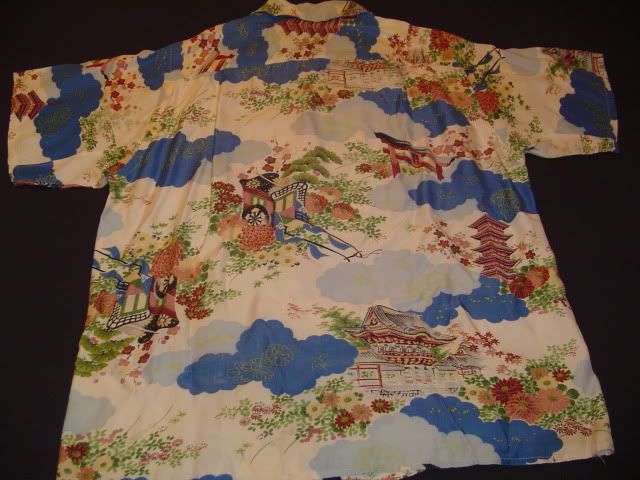
The traditional Japanese mentality is very important to members of yakuza families and organizations, reflecting that the original owner of this shirt was a member of the yakuza living somewhere in Okinawa.
All in all, Yakuza 3 and the rest of the series are extremely fun games, and Okinawa and the Ryukyu islands are obviously a very fun place to live and extremely interesting and rich culturally.
No comments:
Post a Comment